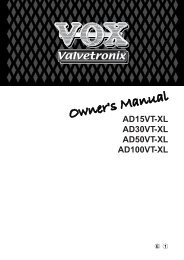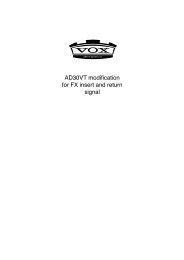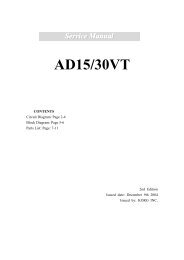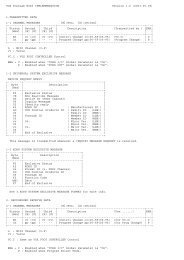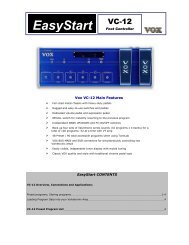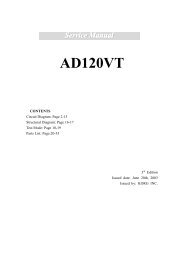ToneLab LE's manual - Vox
ToneLab LE's manual - Vox
ToneLab LE's manual - Vox
Create successful ePaper yourself
Turn your PDF publications into a flip-book with our unique Google optimized e-Paper software.
Quick Start<br />
A GUIDE FOR THOSE WHO WANT TO PLAY GUITAR FIRST,<br />
AND READ THE MANUAL LATER!<br />
Yep, we know. You’d rather be playing guitar than reading this <strong>manual</strong>. Who wouldn’t? I<br />
know I would so here’s a “Quick Start” to get you up and running without delay (pun<br />
intended)<br />
First we’ll get started by trying out <strong>ToneLab</strong> LEs programs and then we’ll explain how to<br />
use the various controls and knobs to create your own sounds.<br />
Right. Once you’ve gotten the urge to play out of your system, you should really give<br />
this <strong>manual</strong> a chance — it’s been written by a fellow guitar fanatic and is full of useful tips and<br />
info that’ll give you much more detail about <strong>ToneLab</strong> LE than what’s in the “Quick Start.”<br />
Okay, okay, we’re almost done here. I just want to recommend that you refer to the illustrations<br />
of the top and rear panels and display in “A Guitarist’s Guided Panel Tour” (p.12) so you<br />
can see the pictures while we talk and you tweak. Now let’s plug in and play!!!<br />
SETUP<br />
1. If you’re connecting <strong>ToneLab</strong> LE to a mixer or recorder, connect OUTPUT jacks L/MONO<br />
and R (7.6) to the input jacks of your mixer or recorder. If you’re listening through headphones,<br />
connect your headphones to the HEADPHONES jack (7.8).<br />
If you’re connecting <strong>ToneLab</strong> LE to a guitar amp(s) connect OUTPUT jacks L/MONO and R<br />
to the input jacks of your guitar amp(s).<br />
NOTE: If you’re connecting <strong>ToneLab</strong> LE to something that only has a mono input, just use the L/MONO<br />
jack.<br />
2. Turn the LEVEL knob (7.7) on the rear panel of <strong>ToneLab</strong> LE all the way to the left (as viewed<br />
from the rear), setting the volume to 0.<br />
3. Plug the supplied AC/AC power supply into <strong>ToneLab</strong> LE’s rear panel AC9V power inlet (7.3),<br />
and plug the power supply into an AC wall socket.<br />
4. Plug your guitar into the rear panel INPUT jack (7.4).<br />
5. Before you turn <strong>ToneLab</strong> LE on, lower the volume of your amp or mixer so you don’t hear<br />
any potentially speaker-damaging pops or buzzes. Then turn on the STANDBY switch (7.2)<br />
to power up <strong>ToneLab</strong> LE.<br />
6. If you connected <strong>ToneLab</strong> LE to a mixer or recorder, press the AMP/LINE button to select<br />
the AMP/LINE menu, and use the value knob 1 to select “Ln1, 2” (LINE). If you’ve connected<br />
<strong>ToneLab</strong> LE to your guitar amp, set this to “AP1–3” (AMP) setting.<br />
HINT: If you’ve connected <strong>ToneLab</strong> LE to your guitar amp, select the setting that is best for your amp.<br />
(p.21)<br />
HINT: If you selected “Ln2” (LINE), you can use a three-band EQ to adjust the tone that would best<br />
suit your output settings. (p.25)<br />
7. Turn up the volume controls on your amp or mixer, and use <strong>ToneLab</strong> LE’s rear panel LEVEL<br />
knob to adjust the volume.<br />
NOTE: You won’t hear sound for several seconds while the valve (a.k.a. “vacuum tube” if you live on<br />
the west side of the Atlantic) warms up. This isn’t a malfunction — it’s a real analogue valve!<br />
6




